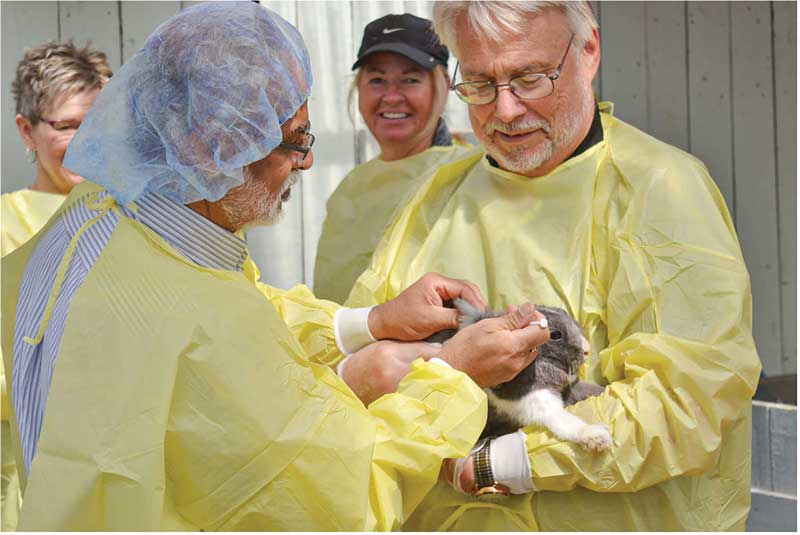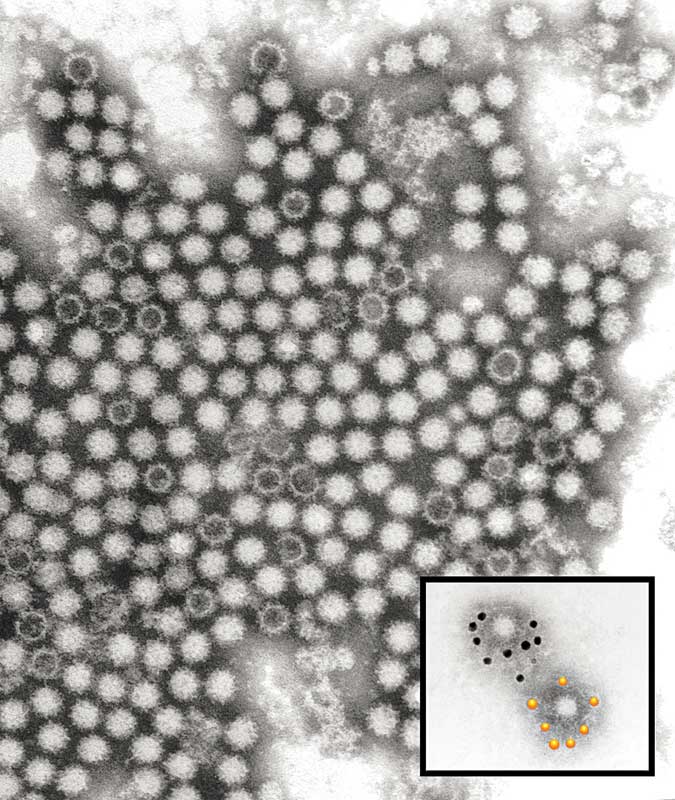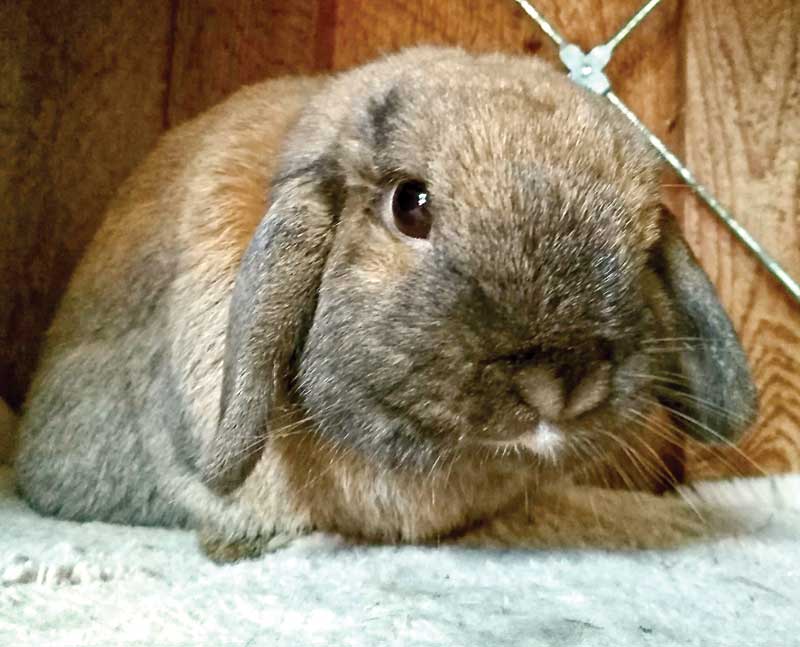
In early spring of 2018, I began to experience something I had been blessedly spared until then: recurrent nightmares. In them, my beloved pet rabbit would fall ill and die from rabbit hemorrhagic disease virus (RHDV), a contagion newly arrived on North American shores. Entire colonies of feral domestic rabbits in Richmond, B.C. and parts of Vancouver Island were wiped out. Rabbit owners and rescuers in these areas suffered sudden and devastating losses. As is often the case at the onset of a calamity, too many people did not realize what had hit their rabbits and how serious it was.
RHDV causes acute fatal hepatitis and liver failure, with fever and multiple organ hemorrhages in the absence of clotting factors normally produced by the liver. In the most acute form of the illness, hemorrhage may not even have time to develop, and the rabbit dies with vague symptoms that fit many other conditions.
During those early days, our clinic receptionist mentioned to me one morning a lady had called asking what to give her young rabbits to stop them dying en masse. When I realized what was going on, we immediately called the owner back. This case was to become one of the first reports by the Canadian Food Inspection Agency (CFIA) to the World Organization for Animal
Health (WOAH).
Together with this owner of a meat rabbitry, we documented the events on her farm and communicated with British Columbia’s provincial Animal Health Centre about testing of deceased animals. Unfortunately, it was too late to protect the rabbits that had survived the first wave of deaths on the farm. The learning curve was steep for everyone involved. To this day, I wonder how many similar cases had gone—and continue to go—undocumented in the process of mapping the outbreaks and spread of the virus.
Tests on deceased rabbits showed they had died of RHDV2, a more virulent genotype of the virus than its predecessor RHDV1. This new genotype had originated in France around 2010. It carried a mortality rate of around 80 percent and, unlike RHDV1, infected and killed young and adult rabbits.1
Almost as abruptly as it had started, the spring 2018 outbreak died down. Rabbit owners began to hope the virus had somehow burned itself out; that this was an isolated event in the history of the virus in North America. There had been previous isolated cases of RHDV in North America even prior to 2018.2
Then, in 2019, deceased feral rabbits were found in new areas of Vancouver Island, as well as in parts of Washington state in close geographic proximity to the Canadian cases. RHDV2 was confirmed yet again—but this time, it was represented by different strains or variants than the previous one. Had the 2018 strain mutated into new ones, or were the 2019 cases caused by a new foreign incursion altogether?
When, in March 2020, the virus hit U.S. rabbit populations on a mass scale, it first appeared in the south of the country and not in the areas close to the 2018-2019 outbreaks.3 The same period saw an outbreak of RHDV2 among Mexico’s farmed rabbits.4 Alarmingly, the 2020 cases affected not only domestic rabbits, but also native North American wild rabbits and hares. This was a new development; the 2018 and 2019 variants of the virus were known to affect only European rabbits.
RHDV has been known in Europe and Australia since 1984 and 2015, respectively. Its behavior has been studied in detail. Unlike viruses that settle into less aggressive behavior after attacking a newly found host species, RHDV2 appears to be evolving in the direction of greater rather than lesser virulence.5 At the same time, there are many non-pathogenic lagoviruses (caliciviruses affecting rabbits and hares) genetically related to RHDV2. The dynamic and rapidly evolving nature of RHDV2 relies on frequent recombination events involving a large number of both pathogenic and non-pathogenic strains. Capucci et al concluded “highly pathogenic RHDV2 strains have emerged during the virus’s evolution and have become prevalent in the field.”6
As of writing, RHDV2 has been confirmed in 28 U.S. states and three Canadian provinces.7 Since 2018, its status gradually changed from foreign disease slated for eradication, to emerging pathogen, to endemic. It is here to stay, and continues to evolve. In February 2023, a new variant killed the entire feral rabbit population of the town of Courtenay, B.C., the site of one of the 2018 outbreaks. The same new variant was responsible for the death of one of my own pets, a recently rescued feral rabbit that had been vaccinated but whose immune system was likely weakened by stress and underlying health issues. In June 2023, the virus was busy killing off the feral rabbit population of the town of Langley on Whidbey Island, WA.8
The first question many pet owners ask is whether RHDV2 is dangerous to humans, dogs, and cats. A scientist’s answer to such a question is, “There are no known cases.” At this time, the virus is known to infect and kill only lagomorphs (rabbits and hares).

The continent fights back
For a short while after the virus first hit in 2018, British Columbia’s only defense was biosecurity measures. The virus travels easily, is very hard to kill, and survives for at least three months on fomites, and at least eight months inside carcasses of deceased rabbits under favorable temperatures.
Thanks to the combined efforts of the veterinary community, British Columbia’s chief veterinary officer, Jane Pritchard, BA, DVM, MVS, and the CFIA, emergency import of the French-produced vaccine Filavac began in April 2018. The vaccine has been available in Canada ever since, yet it is still technically not licensed in the country. There are no plans to develop or produce a domestic Canadian vaccine.
The U.S. initially relied on emergency import of Filavac and another European-made vaccine, Eravac. Vaccination was made possible for domestic rabbits in states where the virus had been confirmed, but not only to them. A program was implemented to vaccinate endangered Columbia Basin pygmy rabbits in Washington state.9 In 2021, U.S.-based company Medgene launched a domestic vaccine against RHDV2 based on a novel approach: platform technology, which allows for fast response to emergence of new variants of the virus and mass production of much-needed vaccine.10
Mexico’s response was swifter than that of its neighbors to the north. The economic importance of rabbits as a meat source, combined with a centralized government with strong communist traditions, resulted in prompt development and widespread use of a domestic vaccine for farmed rabbits, and in a limited-time program of free vaccination of pet rabbits across the entire country.11
The evolution and spread of the virus rely largely on the density of the rabbit population it encounters. In this context, effective rescue of feral domestic rabbits, as well as educational and administrative efforts at preventing their abandonment in the first place, will be an important barrier to the spread of the virus.12
Since vaccination, no matter the efficacy, cannot guarantee complete protection from the virus, biosecurity measures remain an important consideration for anyone who keeps rabbits, whether as pets, livestock or rescues.13,14
An important lesson taught by the virus over and over is that rabbits that live exclusively indoors are not entirely safe from the virus, and rely on vaccination and biosecurity for their protection as much as do outdoor rabbits.

Environmental and social impacts
Lessons learned in Europe and Australia can better prepare North America to mitigate the effects of RHDV on wild lagomorph populations. The main concerns are loss of biodiversity and genetic diversity through decrease in populations of wild rabbits and hares. Some of these species are already endangered. As prey species, rabbits and hares are an important food source for many native predators, both mammals and birds, and the loss of a food source can have dire consequences for an entire ecosystem. Lagomorphs are also a key factor in the spread of seeds of native vegetation, and as such, they impact the flora as well as the fauna of an ecosystem.15
In Canada and the U.S., where rabbit farming is not a major factor, the main significance of the domestic European rabbit is that of pet species inspiring a very strong human-animal bond. If any good can come out of the arrival of RHDV2, it is the drive for education of veterinarians, government organizations, and the public, with a view to providing rabbits with the level of attention and care they deserve.
Veronica Gventsadze M.A., PhD, DVM, worked as a conference interpreter and a university professor of philosophy before turning her love of animals and biology into the profession of a veterinarian. Upon graduating from Ontario Veterinary College in 2008, Dr. Gventsadze moved to British Columbia, where she practices as a small animal veterinarian, with a particular fondness of rabbits. She can be reached through her website https://veronica-gventsadze.com/contact/.
References
- https://veterinaryresearch.biomedcentral.com/articles/10.1186/1297-9716-44-81
- https://www.wormsandgermsblog.com/2011/05/articles/animals/other-animals/rare-rabbit-infection-in-manitoba/
- https://rhdv2.org/rhdv2-history/
- https://www.gob.mx/cms/uploads/attachment/file/554870/Plan_de_emergencia_para_la_atenci_n_de_un_brote_de_la_EHVC_en_M_xico.pdf
- https://www.ncbi.nlm.nih.gov/pmc/articles/PMC8570162/
- https://bvajournals.onlinelibrary.wiley.com/doi/pdf/10.1136/vr.104132
- https://rhdv2.org/where-is-rhdv2/
- https://www.kiro7.com/news/local/devastating-disease-decimating-langley-bunnies-whidbey-island/5JSMOCKTHNEELERE7WARQJPRAE/
- https://news.vin.com/default.aspx?pid=210&Id=10590311&f5=1
- https://medgenelabs.com/rabbits/
- https://www.gob.mx/senasica/articulos/inicia-vacunacion-de-conejos-mascota-en-todo-el-pais
- https://rabbitats.org/
- https://spca.bc.ca/wp-content/uploads/2022/10/Rabbit-Hemorrhagic-Disease-Information-Sheet-for-Rabbit-Guardians-1.pdf
- https://spca.bc.ca/wp-content/uploads/2023/01/Rabbit-Hemorrhagic-Disease-Information-Sheet-for-Shelters-1.pdf
- https://rhdv2.org/ecological-impacts/
